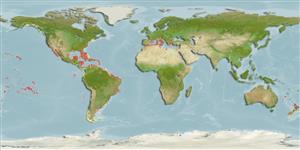Common names from other countries
Environment: milieu / climate zone / depth range / distribution range
Écologie
Benthopélagique; profondeur 0 - 20 m (Ref. 116114). Subtropical
Distribution
Pays | Zones FAO | Écosystèmes | Occurrences | Introductions
Eastern Central Pacific, Western Central Atlantic and the Mediterranean.
Length at first maturity / Taille / Poids / Âge
Maturity: Lm ? range ? - ? cm Max length : 4.0 cm H mâle / non sexé; (Ref. 2376)
Stings are painful; second most important stinging jellyfish on the southcoast of Italy; in the coast of Denia (Western Mediterranean Sea), summer of 2008, it showed an unusual high density and stung as many as 185 people d-1 (Ref. 116819). Neritic (Ref. 116114). Inhabits near shore, mangrove channels, and kelp forests (Ref. 1028). Polyps were once located attached to bivalve shells in a mangrove habitat in Puerto Rico, suggesting estuarine polyps (Ref. 116835). Medusae are associated with sandy beach with Posidonia oceanica meadows (Ref. 116819). Pathogenic (Ref. 116114). Mainly feeds on copepods, mysids and gammarids (Ref. 116521). Temperature is the main factor which affects its spatio-temporal abundance along the SW Mediterranean; other variables were low salinity and high coastal productivity (chl a and phosphate) (Ref. 116819).
Cairns, S.D., D.R. Calder, A. Brinckmann-Voss, C.B. Castro, D.G. Fautin, P.R. Pugh, C.E. Mills, W.C. Jaap, M.N. Arai, S.H.D. Haddock and D.M. Opresko. 2003. (Ref. 1663)
Statut dans la liste rouge de l'IUCN (Ref. 130435)
statut CITES (Ref. 108899)
Not Evaluated
Not Evaluated
Menace pour l'homme
Harmless
Utilisations par l'homme
| FishSource |
Outils
Plus d'informations
Taille/Âge
Croissance
Longueur-poids
Longueur-longueur
Morphologie
Larves
Abondance
Sources Internet
Estimates based on models
Vulnérabilité
Low vulnerability (10 of 100).
Catégorie de prix
Unknown.
